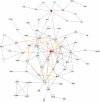Human endometriosis is associated with plasma cells and overexpression of B lymphocyte stimulator
- PMID: 17640886
- PMCID: PMC1941489
- DOI: 10.1073/pnas.0703451104
Human endometriosis is associated with plasma cells and overexpression of B lymphocyte stimulator
Abstract
Endometriosis affects 10-20% of women of reproductive age and is associated with pelvic pain and infertility, and its pathogenesis is not well understood. We used genomewide transcriptional profiling to characterize endometriosis and found that it exhibits a gene expression signature consistent with an underlying autoimmune mechanism. Endometriosis lesions are characterized by the presence of abundant plasma cells, many of which produce IgM, and macrophages that produce BLyS/BAFF/TNFSF13B, a member of the TNF superfamily implicated in other autoimmune diseases. B lymphocyte stimulator (BLyS) protein was found elevated in the serum of endometriosis patients. These observations suggest a model for the pathology of endometriosis where BLyS-responsive plasma cells interact with retrograde menstrual tissues to give rise to endometriosis lesions.
Conflict of interest statement
Conflict of interest statement: A.H., R.B.R., P.H., D.G., E.W., P.J.C., R.A.M., and A.Z. were employed by Neurocrine Biosciences and owned common stock of this company at the time this study was performed.
Figures



References
-
- Lebovic DI, Mueller MD, Taylor RN. Fertil Steril. 2001;75:1–10. - PubMed
-
- Giudice LC, Kao LC. Lancet. 2004;364:1789–1799. - PubMed
-
- Berkley KJ, Rapkin AJ, Papka RE. Science. 2005;308:1587–1589. - PubMed
-
- Brosens I, Puttemans P, Campo R, Gordts S, Brosens J. Curr Opin Obstet Gynecol. 2003;15:519–522. - PubMed
-
- Valle RF, Sciarra JJ. Ann NY Acad Sci. 2003;997:229–239. - PubMed
MeSH terms
Substances
LinkOut - more resources
Full Text Sources
Other Literature Sources
Medical
Molecular Biology Databases

